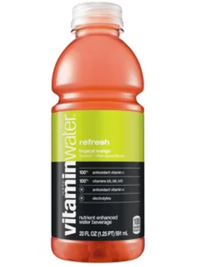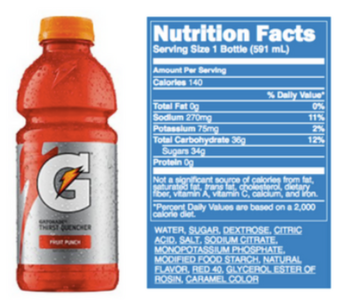Course:FNH200/Assignments/2021/Sports drinks Vs Common drinks
Introduction of the food products


Sports drink is a kind of health drink developed on the basis of science, aiming at the energy consumption during exercise, the change of internal environment and the decrease of cell function. It can quickly supplement water, electrolyte and heat for human body before, during and after exercise, maintain and promote body fluid balance and quickly relieve fatigue. The application of sports drinks can improve the metabolic process and body temperature regulation, which is a positive means to promote sports training, competition and fitness[2].
Pictures of products
Common drink and Sport drink (display on the right)

Ingredient lists
Lists of ingredients
| Ingredients | Identify fat substitute, sugar substitute, additives | Explain their roles, and what they contribute to the product |
|---|---|---|
| Water | Base ingredient | |
| Sugar | Base ingredient | Increase the sweetness. |
| Dextrose | Base ingredient | A sugar that is more easily absorbed. |
| Citric Acid | Additives | A flavoring and a preservative. |
| Salt | Base ingredient | Salt is one of the electrolytes. |
| Sodium Citrate | Additives | A "sodium salt of citric acid" this chemically processed food additive is used to regulate acidity. |
| Monopotassium Phosphate | Additives | It's a common food additive as well as a fertilizer and fungicide. |
| Modified Food Starch | Additives | Another chemically processed food stabilizer. |
| Red 40 | Additives | |
| Glycerol Ester of Rosin | Additives | A food additive designed to keep oils suspended or evenly mixed in water. |
| Caramel Color | Additives | Another artificial coloring additive. |
| Natural Flavors | Additives | To impart flavor to the drink. |
| Ingredients | Identify fat substitute, sugar substitute, additives | Explain their roles, and what they contribute to the product |
|---|---|---|
| Water | Base ingredient | |
| Crystalline Fructose | Additives | Increase the sweetness. |
| Cane Sugar | Base ingredient | Increase the sweetness. |
| Citric Acid | Additives | A flavoring and a preservative. |
| Potassium Phosphate | Additives | Electrolyte Sources. |
| Calcium Lactate and Magnesium Lactate | Additives | Electrolyte Sources. |
| Natural Flavors | Additives | To impart flavor to the drink. |
| Vitamin | Base ingredient | A nutrient. |
| Lycopene | Additives | Artificial coloring additive. |
| B-Apo-8'-Carotenal | Additives | Another artificial coloring additive. |
The differences between sports drinks and common drinks
Sports drink is a kind of low permeability drink. If the concentration of electrolyte and sugar in the drink is too high, the osmotic pressure will increase correspondingly, which will slow down the emptying speed of the drink in the stomach and easily cause abdominal distention, and eventually affect the sports ability and performance. Therefore, sports drinks must be hypotonic[2].
Sugar content. The sugar content of sports drinks is generally between 4% and 8%. For better sports drinks, there are strict requirements on the type of sugar, which are mostly oligosaccharides. This can not only reduce the sweetness, but also provide more sugar supply without affecting the absorption, so as to quickly supplement the body's energy and relieve fatigue[2][4].
The content of electrolyte. Sports drinks are rich in sodium, potassium, calcium, magnesium and other mineral elements, the concentration of which is equivalent to the electrolyte in human body, and can quickly supplement the mineral content lost due to sweating[2].
Labels
Necessary food labelling requirements
Common name of food: Gatorade & Vitamin water
Bilingual labelling: both English and French (official languages in Canada)
Country of origin: United Stated
Production date and shelf-life: mostly in 2021 and storage life is about 1 year or less
Identity and principal place of business: PepsiCo, Inc. & The Coca-Cola Company
Irradiated food: Not irradiated
Location and legibility: All labels are shown clearly on the product (the front/back of the bottle).
List of ingredients: Clearly shown on the product
Nutrition facts table: Contains all required information (like sugar, calories, protein, calcium, iron and so on)
Food additives: Clearly shown on the list of ingredients
Preservation conditions: Once opened, refrigerate at low temperature; unopened, store at room temperature, out of direct sunlight
Compare the information (labels) with the regulatory requirements
All the inforamtion meets the regulatory requirements in the section 4 of "The Food and Drugs Act of Canada".
No person shall sell an article of food that:
(a) has in or upon it any poisonous or harmful substance;
(b) is unfit for human consumption;
(c) consists in whole or in part of any filthy, putrid, disgusting, rotten decomposed or diseased animal or vegetable substance;
(d) is adulterated;
(e) was manufactured, prepared, preserved, packaged or stored under unsanitary conditions[5]. (Cited from section 4 of "The Food and Drugs Act of Canada")
Personal Choice
Please submit your individual component of this assignment on Canvas to protect your privacy and your personal opinion
References
- ↑ 1.0 1.1 "Vitaminwater".
- ↑ 2.0 2.1 2.2 2.3 2.4 2.5 2.6 Jaime, A. (2021). "What's Really in Sport Drinks".
- ↑ "Glaceau Vitaminwater Refresh Tropical Mango Water Beverage". 2021.
- ↑ Zytnick, D. (2015). "Knowledge for Sugar Content of Sports Drinks is Not Associated with Sports Drinks Consumption". American journal of health. 30 (2): 101–108.
- ↑ "The Food and Drugs Act of Canada". 1985.
| This Food Science resource was created by Course:FNH200. |
